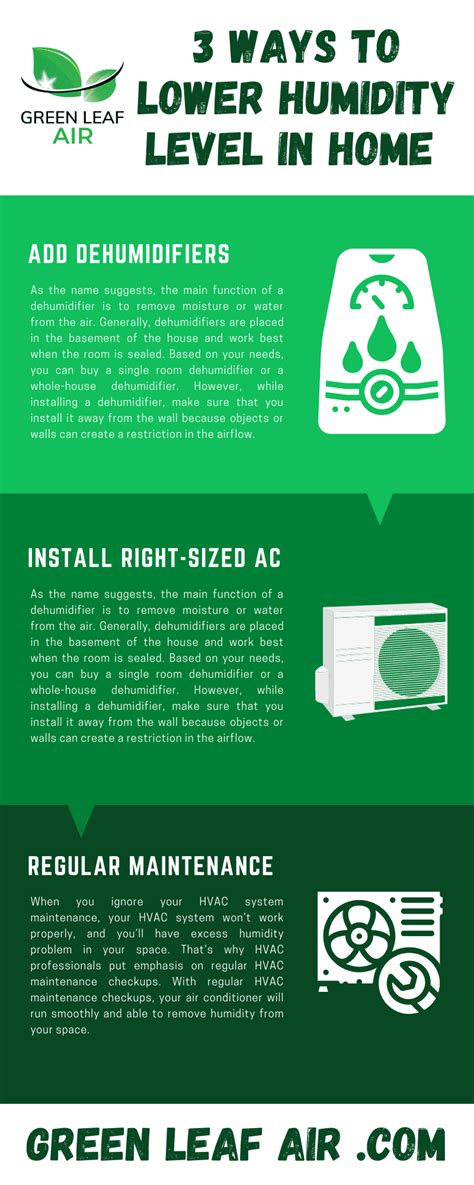How To Lower Humidity In Your House: A Comprehensive Guide
High humidity can be a real nuisance, leading to mold growth, musty odors, and discomfort. But don't despair! Lowering the humidity in your house is achievable with a combination of strategies. This guide will walk you through effective methods, helping you create a more comfortable and healthy living environment.
Understanding Humidity and Its Effects
Before diving into solutions, it's crucial to understand what humidity is and why it matters. Humidity refers to the amount of water vapor present in the air. High humidity levels (above 50%) create a breeding ground for mold and mildew, potentially leading to respiratory problems and allergies. It can also make your home feel sticky and uncomfortable, even in moderate temperatures.
Effective Ways to Reduce Humidity in Your Home
Here's a breakdown of proven methods to combat high humidity, ranging from simple adjustments to more significant investments:
1. Air Conditioning: Your First Line of Defense
Air conditioners are highly effective at dehumidifying the air. As they cool the air, they also remove moisture. This is often the most effective solution, especially during hot, humid weather. Consider: Regular maintenance of your AC unit is crucial for optimal performance and efficient dehumidification.
2. Dehumidifiers: Targeted Moisture Removal
Dehumidifiers are specifically designed to extract moisture from the air. They're particularly helpful in damp rooms like basements or bathrooms. Choose wisely: Select a dehumidifier based on the size of the room you intend to use it in. Larger rooms require more powerful units.
Types of Dehumidifiers:
- Refrigerant dehumidifiers: These are the most common type and are effective in removing large amounts of moisture.
- Desiccant dehumidifiers: These work well in colder environments where refrigerant dehumidifiers may struggle.
3. Ventilation: Circulate and Eliminate
Proper ventilation plays a key role in reducing humidity. This involves:
- Exhaust fans: Use exhaust fans in bathrooms and kitchens to remove moisture-laden air during showers and cooking.
- Open windows: When weather permits, open windows to allow for natural air circulation. This is especially effective when coupled with a cross-breeze.
- Ceiling fans: These help circulate air and prevent moisture from accumulating in one area.
4. Addressing Moisture Sources
Tackling the root cause of humidity is crucial for long-term control. This includes:
- Leaks: Repair any leaky pipes, faucets, or roofs promptly to prevent water from accumulating.
- Condensation: Ensure proper ventilation in areas prone to condensation, such as windows and walls. Consider using window dehumidifiers.
- Plants: While plants add beauty to your home, they also contribute to humidity. Monitor the number of plants and their watering schedule.
5. Home Improvements for Humidity Control
For more permanent solutions, consider these upgrades:
- Improved insulation: Proper insulation helps prevent moisture from entering your home.
- Vapor barriers: Installing vapor barriers in your walls and ceilings can help control moisture movement.
- Sump pumps: In basements prone to flooding, a sump pump can effectively remove excess water.
Maintaining Low Humidity Levels
Once you've successfully lowered the humidity, it's essential to maintain it. Regularly check humidity levels using a hygrometer and adjust your strategies accordingly. Remember, preventative measures are just as important as reactive ones.
Conclusion: Breathe Easy in a Dry Home
By implementing these strategies, you can effectively lower the humidity in your house, creating a healthier and more comfortable living space. Remember to tailor your approach to your specific needs and climate. Don't hesitate to consult a professional for more significant issues or complex situations. A little proactive effort can go a long way in ensuring a dry and comfortable home for you and your family.
